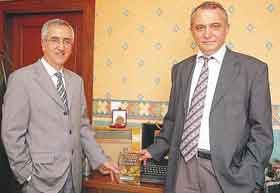Bas?nda Mus2okur
Turkish Daily News Gazetesi, 20 Haziran 2008

Yaz?n?n kupürünü görmek için t?klay?n?z.
A software program on Ottoman music
VERC?HAN Z?FL?O?LU / ISTANBUL

Mathematicians Kemal Karaosmano?lu and Süleyman Metin Y?lmaz have
developed a database software program of Ottoman classical music. Called
Mus2okur, the software contains musical notes of thousands of Ottoman classical
works
An incredible collection of the musical notes
of Ottoman classical works has been gathered
together in a revolutionary new software program
created by two Turkish mathematicians.
Mathematicians Kemal Karaosmano?lu and
Süleyman Metin Y?lmaz spent years looking at
musical manuscripts of a myriad of Ottoman
classical songs and instrumental works found in
the dusty archives of TRT, Turkey's first and
only state television and radio station. As a
result of this meticulous study, they applied
the musical notes of more than 1,500 classical
works to database software they created, calling
the result Mus2okur. The software program not
only contains the musical notes of centuries-old
Ottoman works, but also their lyrics and
information about the composers. In addition,
each song in Mus2okur is provided with a
“makam,” melodic mode, and “usul,” underlying
rhythmic cycle that complements the melodic
rhythm and helps shape the overall structure of
a composition in Ottoman classical music.
Mus2okur also contains an index of a total
of 24,000 different Ottoman classical works with
their descriptive characteristics. All the works
can be applied to 128 different musical
instruments on a music computer and can be
played with a fretless guitar.
Mus2okur is a masterpiece, said Karl
Signell, world-renowned U.S. ethnomusicologist
and scholar of Turkish classical music.
“Mus2okur is one of the most successful
studies I have ever witnessed and is a unique
source for addicts and researchers of Ottoman
classical music,” said Periklis Tsoukalas, a
Greek musician who specializes in Eastern
music.
In the early years of the Turkish Republic,
Ottoman classical music was neglected to a great
extent because it evoked a past tradition and
way of life not in line with modernization and
Westernization efforts of the young nation
state. “We have adopted the notation system of
the West and simply ignored our own classical
music,” said Karaosmano?lu. “As we turned our
face to the West, we neglected our own music.”
Karaosmano?lu noted that in most Western music,
the octave is divided into 12 semitones, while
Ottoman classical music features a much more
complex range of tones.
Mus2okur also contains information on a
specific music notation system created by
Hampartsoum Limondjian, more commonly known as
Baba Hamparzsum, a prominent Ottoman Armenian
composer of Turkish classical music. Called the
Hampartsoum notation system, the system
Limondjian developed became the main musical
notation system for Turkish classical music.
Limondjian served as royal musician during the
reign of Ottoman Sultan Selim III, who was also
a musician. Hampartsoum notation uses symbols
derived from an older notation called “khaz”
used by the Armenian Church in the eighth and
the ninth centuries.
“The music notation system created by
Limondjian is the basic notation system in the
history of Turkish classical music. Thousands of
old songs are still alive today thanks to
Limondjian's notation system,” said
Karaosmano?lu. “This is the reason why we have
also incorporated his notation system to our
software program,” he said.
Mus2okur's rich database makes it a great
reference on Ottoman classical music for Western
musicians and scholars who are interested in the
unique style of music.
Interaction of math
and music
Karaosmano?lu and Y?lmaz conducted a
meticulous examination of thousands of
manuscripts of musical notes in the dusty
archives of the TRT. “Dating back centuries,
these manuscripts were in a very bad condition.
Many of them were in tatters,” he said, adding
the manuscripts are in need of urgent
protection.
“Touching those musical notes was a
wonderful feeling. They reflect the
centuries-old loves and dreams,” said
Karaosmano?lu. “There were a number of Armenian
and Rum composers of Turkish classical music in the
past centuries*. One cannot
mention Ottoman classical music without making
any references to those great composers and the
great works they produced” he added.
For Karaosmano?lu and Y?lmaz, the success
of Turkish classical music can primarily be
attributed to the peaceful coexistence of
different cultures and ethnicities on the same
land for centuries. “During a certain historical
period, the state radio did not play any works
of Turkish classical music in Turkey,” said
Karaosmano?lu, adding this was a clear indicator
of the Westernization efforts that marked the
period.
www.musiki.org
*This sentence appeared differently
in the newspaper. We kindly requested that it be
corrected as shown above.